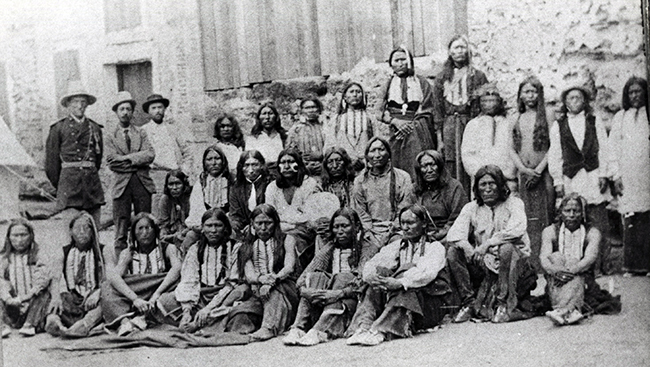Background
Richard Henry Pratt [1] fought in the Civil War as a member of the Union army. He mustered out in 1865 but rejoined two years later, being commissioned a lieutenant, and rose to the rank of captain. He served at Fort Sill, Oklahoma Territory, then was transferred to Fort Marion, Florida. His encounter with the Chickasaw Nation occurred in 1877, when Montford T. Johnson traveled to Fort Marion. Interest in education for First Americans led to Pratt’s founding Carlisle Indian School in Carlisle, Pennsylvania, in 1879. He led the school until his retirement in June 1904 [2, p. 120].
Plains Indians Moved to Oklahoma Territory Reservations
After the Medicine Lodge Treaty between the Plains tribes and the United States government in 1867, the tribes – Arapaho, Cheyenne, Comanche, Kiowa, Kiowa-Apache and Caddo – were driven onto relatively small reservations in Oklahoma Territory, west of Indian Territory’s Chickasaw Nation. They formerly had roamed North America’s vast northern and southern Plains and the Southwest. As compensation, the federal government supplied annuities to the tribes in the form of clothing, axes, bedding, and other domestic and farming implements. The government also began killing and promoting the slaughtering of buffalo to bring the First Americans into further subjection and making them more dependent. The familiar U.S. government tactic of withholding rations from the tribes to encourage compliance was also used.
This resulted in the First Americans distrusting settlers even further. Many First Americans attempted to return to their former lands. Also, the young men of the tribes had been looking forward to becoming warriors. Being herded onto “reservations” and subject to non-aggression treaties deprived them of this honor.
The federal government realized that Fort Arbuckle in the Chickasaw Nation was too far from these reservations to be effective and established a new post near the center of the Plains tribes near Medicine Bluffs and named it Fort Sill. The present-day city of Lawton, Oklahoma, is located just south of the installation.
Tensions grew starting in 1869. Finally, in 1875, under new leadership, the tribes were brought under control in what was called the Indian War. The government’s former policy of accepting the tribes’ promises of no more trouble and forgiveness ended, and much of the leadership from the Caddo, Arapaho, Cheyenne, Comanche and Kiowa tribes were shackled and imprisoned.
Lt. Pratt
Lt. Richard H. Pratt took these chiefs to the prison at Fort Leavenworth, Kansas. From there, they were moved to Fort Marion in St. Augustine, Florida, an old fort that the Spanish had built in the 17th century. The shackled prisoners their reservations. They were not given trials and were to be held for an indeterminate time [2, p. 117].
Lt. Pratt, being familiar with these tribal leaders, was also transferred to Fort Marion and promoted to captain. He was put in charge of the Oklahoma Territory inmates and oversaw their imprisonment until they were paroled by the federal government to Fort Sill in 1878.
St. Augustine residents were frightened of these prisoners at first but became sympathetic after the First Americans voluntarily helped the townspeople deal with some serious emergencies [2, p. 118].
Lt. Pratt also arranged for the tribesmen to help fish for sharks that had invaded the St. Augustine Bay. This was a rare bright spot that became a regular activity for the incarcerated men. They looked forward to hooking and fighting a mighty shark and pulling it to shore. For the most part, however, the prisoners were wan and in poor health. Several died [2, p. 118].
Capt. Pratt Receives Montford Johnson at Fort Marion
Montford Johnson made the train trip to Fort Marion in 1877 or 1878, to visit his friends and seek a way to help them. He took with him his son, Edward Bryant (E. B.), and Montford’s father, Charles “Boggy” Johnson. They traveled from the Chickasaw Nation to Houston, Texas, then on to St. Augustine [2, p. 116].
The prisoners were overjoyed to see Montford. His visit gave them hope, and they pleaded for his help in persuading the United States government to let them go home. He promised to do all he could. Montford’s father, Charles, had told him he had influential friends in Washington, D. C., whom he believed could help [2, p. 117].
Montford Johnson asked and received Capt. Pratt’s permission to secure a cow and bring it to the prisoners for a barbecue. E. B. finally found one that was not “skin and bones” and hired a butcher to get it ready. The First Americans were overcome with joy when they realized what was happening and reveled in a sumptuous feast [2, p. 119].

Photo courtesy of the National Parks Service
Charles “Boggy” Johnson seeks the Fort Marion prisoners’ release
Charles Johnson did indeed pursue his Washington contacts and met with his friend, Sen. Augustus Hill Garland from Arkansas, who promised to discuss the prisoners’ circumstance with President Hayes. How much Charles’ efforts had to do with the release is not known, but by April 1878, the U.S. War Department had paroled the prisoners and returned them to their agency in Oklahoma Territory, except for some of the young men. The government sent them to the newly opened Carlisle Indian School in Carlisle, Pennsylvania, which Capt. Pratt helped establish and operate. [1, p. 120]